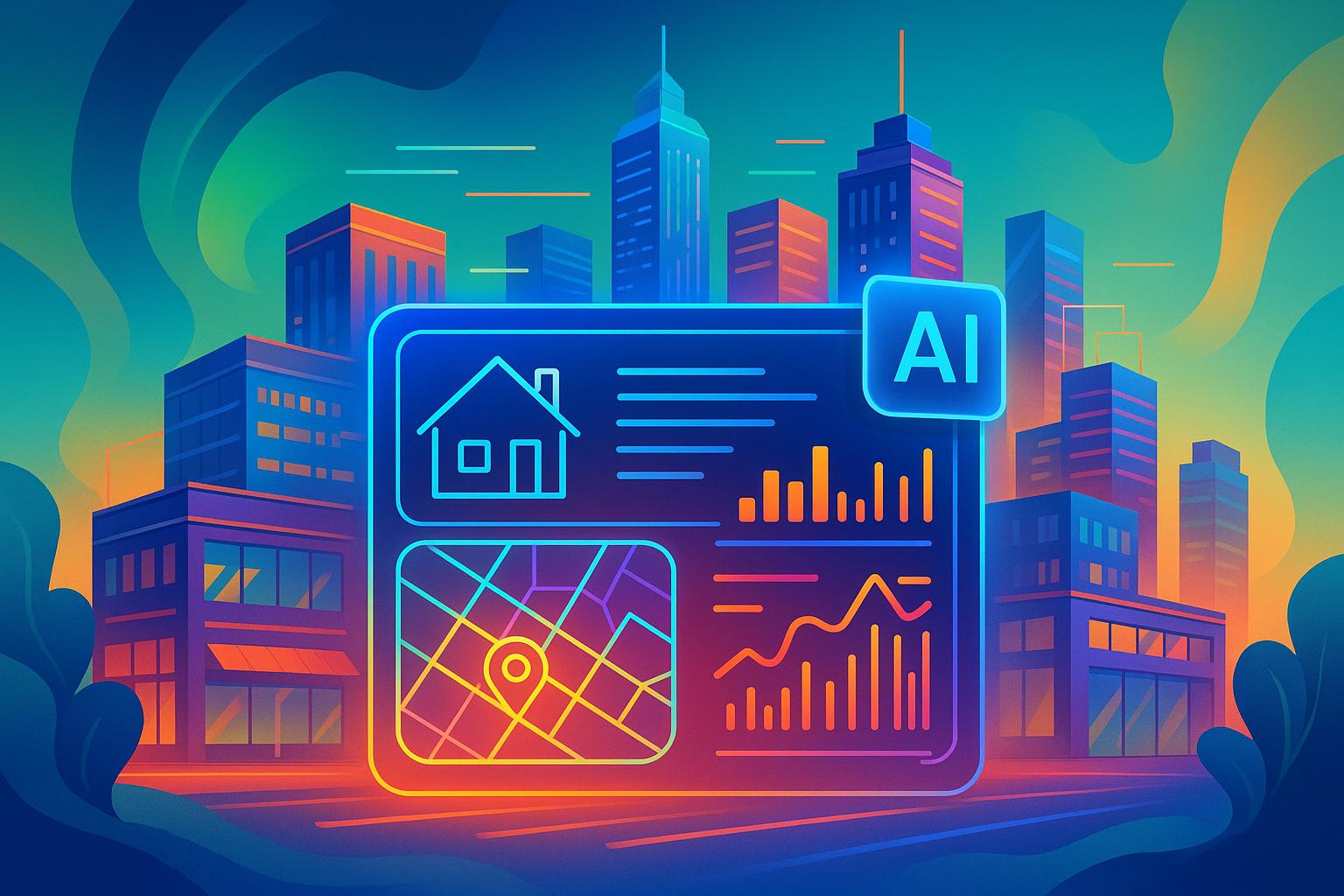AI and GIS are revolutionizing property price analysis in real estate. Here's what you need to know:
- AI crunches massive amounts of data to predict property values
- GIS provides spatial context and visualization of property data
- Combined, they offer faster, more accurate valuations and market insights
Key benefits:
- Speed: AI valuations in seconds vs. weeks for manual appraisals
- Accuracy: AI models reduce human bias and errors
- Data integration: GIS maps show property info and market trends visually
- Predictive power: AI forecasts future property values and market shifts
Real-world impact:
| Area | Improvement |
|---|---|
| Valuation accuracy | 98% for on-market homes |
| Error rate | As low as 2.4% nationwide |
| Data points analyzed | Millions per property |
| Time saved | Hours to days per valuation |
Bottom line: AI-GIS tools give real estate pros a major edge in making data-driven decisions and staying ahead of market trends.
Related video from YouTube
Common Problems in Property Price Analysis
Property price analysis is tricky. Let's look at the main issues and how AI-GIS is shaking things up.
Old Methods Fall Short
Traditional property valuation has some big problems:
It's slow. Manual appraisals take forever.
It's inconsistent. Two appraisers might give you totally different numbers.
It's limited. Old methods miss out on a ton of valuable data.
Data Overload
Real estate data is a mess:
It's scattered. Information is all over the place.
It's often wrong. Getting accurate, up-to-date info is a pain.
Many real estate pros don't know how to crunch numbers.
AI and GIS to the Rescue
Here's how AI and GIS are fixing these headaches:
1. Speed and Accuracy
AI-powered tools like Zillow's Zestimate are crazy fast and accurate. We're talking a 2.4% error rate for on-market homes. That's impressive.
2. No More Guesswork
AI doesn't play favorites. It just looks at the facts. As Jessica Alford from LightBox says:
"Staying ahead means leveraging technology not just for data access but for intelligent, actionable insights that drive better decision-making."
3. Sees the Big Picture
AI can process MILLIONS of data points. It spots things humans might miss, leading to smarter property valuations.
4. Always Up-to-Date
GIS tools pull in fresh data constantly. Your valuations won't be outdated by the time you finish them.
5. Easy to Use
New AI-GIS platforms make complex data a breeze to understand. Take Plotzy - it uses AI for parcel searching and instant zoning answers. Property research just got a whole lot easier.
But remember, AI and GIS are tools, not magic wands. Use them wisely. Jeff Garvin from Bank OZK puts it well:
"Good appraisers are going to become great appraisers by using AI. Bad appraisers are going to become dangerous by using AI."
In other words: AI can make you better at your job, but it won't do your job for you.
Main Parts of AI-GIS Systems
AI-powered Geographic Information Systems (GIS) are shaking up property price analysis. Here's how these systems work:
Getting Location Data
AI-GIS systems thrive on good location data. They pull info from public records, property listings, recent sales data, and even satellite imagery.
Take Reonomy, for example. They dig into public records and private databases to paint a full picture of properties.
AI Price Prediction Tools
This is where things get interesting. AI algorithms crunch numbers to predict property values. It's a four-step dance:
1. Data processing: The system cleans up the raw data.
2. Feature engineering: It picks out what really matters for price.
3. Model training: The AI learns from past data to make future guesses.
4. Real-time updates: New info keeps flowing in to keep predictions sharp.
HouseCanary's AI is a standout here. Their models dive into millions of data points, from market conditions to historical sales, to predict property values with impressive accuracy.
Maps and Data Tools
These tools help users make sense of the data flood. We're talking interactive maps, data visualization features, and search options that let you filter through properties like a pro.
Plotzy's AI-powered parcel searching is a game-changer. Want to filter properties by zoning? They've got you covered.
Here's a quick look at why these features matter:
| Feature | Why It's Cool |
|---|---|
| Interactive maps | Spot property locations in a snap |
| Data visualization | See trends without drowning in numbers |
| Search filters | Find your needle in the property haystack |
The real magic happens when all these parts work together. It's like having a supercharged property analysis toolkit in your pocket.
sbb-itb-11d231f
How to Research Properties Better
AI and GIS tools have revolutionized property research. Here's how to use them to level up your game:
Using AI Research Tools
AI platforms like Plotzy supercharge your property research:
- They filter parcels by zoning in seconds
- Provide owner contact info
- Generate detailed property reports
Plotzy's AI parcel search is a game-changer. It filters properties by zoning, cutting hours off your research time.
Understanding Zoning Rules
Zoning info is crucial. It tells you:
- What you can build
- How you can use the land
- Any restrictions
A solid zoning report includes:
| Element | Why It Matters |
|---|---|
| Zoning ordinances | Defines allowed uses |
| Variances | Shows rule exceptions |
| Parking and setbacks | Affects property use |
But watch out - zoning can change. Keep an eye on amendments and jurisdiction shifts.
Time-Based Property Analysis
Analyzing property changes over time reveals trends. Focus on:
1. Historical sales data
This shows how prices have moved over the years.
2. Market conditions
Look at how the area has evolved.
3. Demographic shifts
These can signal future property value changes.
Tools like Realtor.com and Zillow Research offer market trend data. Use these to spot patterns and make smarter investment decisions.
Wrap-Up
AI-powered GIS has changed the game for property price analysis. It's faster, more accurate, and gives us insights we couldn't get before. Here's the rundown:
AI mixes tons of data from different places - property records, market trends, you name it. It then uses this data to give quick, accurate property estimates through Automated Valuation Models (AVMs). This cuts down on human bias and mistakes.
GIS tech lets us see all this data on maps, showing patterns we might miss otherwise. And the best part? What used to take weeks now takes hours.
For real estate pros, this means making smarter decisions based on solid data.
What's Coming Next
The future? It's looking pretty exciting:
AI will get even better at predicting market trends and property values. This means investors can make smarter choices about where and when to put their money.
We'll also see AI-GIS teaming up with other tech:
- IoT devices could collect real-time property data
- Blockchain might make transactions more transparent
- Virtual Reality could change how we view properties
AI-GIS tools will likely play a big role in making cities more sustainable. They'll help find spots for green buildings and figure out how new developments affect the environment.
As AI gets smarter, we might see more personalized property recommendations. Think Netflix, but for real estate.
But it's not all smooth sailing. With more AI in real estate, we'll probably see new rules pop up to deal with data privacy and make sure these AI tools are used fairly.
Bottom line: The real estate world is changing fast. Those who get on board with AI-GIS tools will have a leg up on the competition.
FAQs
How is AI used in real estate valuation?
AI has shaken up property valuation in a big way. Here's how:
AI systems crunch massive amounts of data, spotting patterns that humans might miss. They look at property info, market trends, and economic indicators from all over the world.
These smart algorithms don't just look at the past - they predict future property values too. And because they stick to the data, AI valuations tend to be more objective than human appraisals.
One cool trick? AI mixes geographic data with property info for super-accurate location-based valuations.
"AI algorithms have breathed new life into the property valuation process by offering real-time valuations with a degree of accuracy that was previously unattainable." - Middy Matthews, Author at Medium
Take Zillow's Zestimate tool, for example. It uses AI to give you property value estimates on the spot. And it's pretty good at it - Zillow says its median error rate for on-market homes is just 2.4% nationwide.
So, what's the big deal with AI in real estate valuation? It's fast, accurate, consistent, cost-effective, and can handle multiple properties at once. That's a game-changer for the industry.
| Benefit | Description |
|---|---|
| Speed | Values properties in seconds |
| Accuracy | Uses big data for precise valuations |
| Consistency | Eliminates human inconsistencies |
| Cost-effectiveness | Reduces need for manual appraisals |
| Scalability | Values multiple properties simultaneously |
In short, AI is revolutionizing how we value real estate, making the process faster, smarter, and more reliable than ever before.


